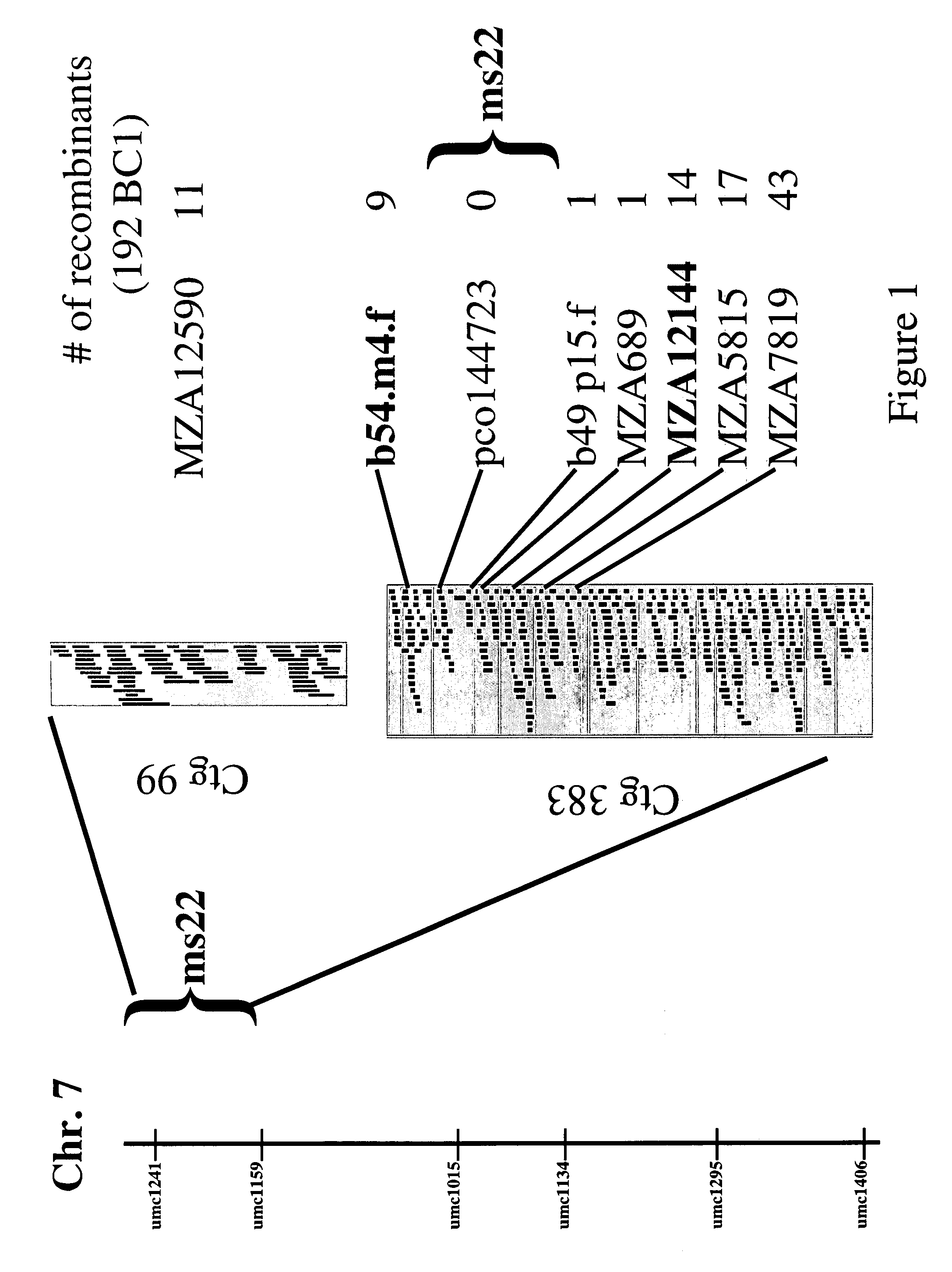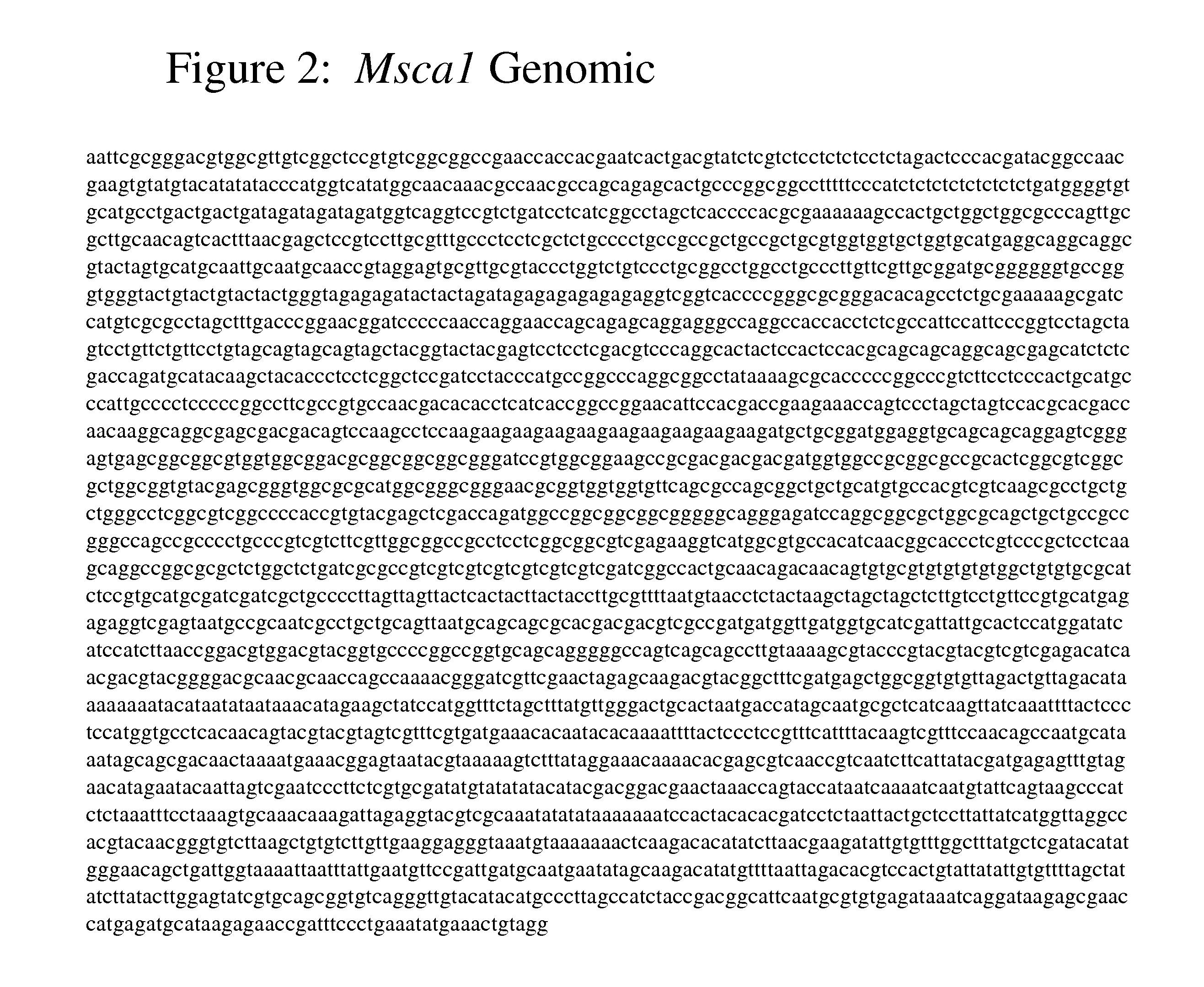Msca1 nucleotide sequences impacting plant male fertility and method of using same
a nucleotide sequence and plant technology, applied in the field of msca1 nucleotide sequences affecting plant male fertility and method of using same, can solve the problems of plant tasseling, not being productive, and presenting a germplasm security risk
- Summary
- Abstract
- Description
- Claims
- Application Information
AI Technical Summary
Benefits of technology
Problems solved by technology
Method used
Image
Examples
example 2
Identification and Cloning of Additional msca1 Alleles
[0123]Two additional mutant alleles of msca1 were available, msca1-mg12 and msca1-6036 (Trimnell M, Fox T, Albertsen MC (2001) New male-sterile mutant allele of Msca1. MNL 75(63):31). Cloning and sequencing of the msca1-mg12 allele revealed a 490 bp deletion in the 3′ region of the glutaredoxin gene. Alignment of a fertile and sterile msca1-mg12 allele is shown in FIG. 5. Alignment of the glutaredoxin region from a wild-type plant (Missouri 17), an msca1-mg12 fertile and sterile plant is shown in FIG. 6. Missing from the sterile plant is the GSH binding site, (LPVVFVGGRLLG; SEQ ID NO: 12). A motif for the redox region, CCMC (SEQ ID NO: 11), was present in the gene, and GSH binding region, LPVVFVGGRLLG (SEQ ID NO: 12), present in fertile plant, is absent in the sterile mutant as can be seen in the alignment shown in FIG. 6.
[0124]In cloning and sequencing of the msca1-6036 allele, a ˜850 bp insertion was detected. Alignment showing...
example 3
Identification of Promoter
[0125]Upstream of the likely translational start codon at 1133 bp of SEQ ID NO: 1 of Msca1, 1132 bp of DNA was present in the genomic clone of Msca1. A reasonable TATA box was observed by inspection, starting at base 921 of SEQ ID NO: 1 and about 200 bp upstream of the translational start codon. See FIG. 9, which is SEQ. ID NO 15. The putative TATA box (TATAAAA) is underlined. Thus, the present invention encompasses a DNA molecule having a nucleotide sequence of SEQ ID NO: SEQ ID NO: 15 (FIG. 9), or those with sequence identity, which hybridize to same under stringent conditions and fragments, and having the function of a male tissue-preferred regulatory region.
example 4
Library Screening to Identify Msca1 from Rice
[0126]As noted above, Msca1 is a male fertility gene in maize. When it is mutated, and made homozygous recessive, male sterility will result. An orthologue of Msca1 was identified in rice. The rice Deleteagene population was prepared and used to screen for individuals harboring deletions of the msca1 gene. (Xin Li et. al A fast neutron deletion mutagenesis-based reverse genetics system for plants. The Plant Journal Volume 27 Page 235—August 2001). With this process, random deletion libraries are produced using fast neutrons to cause mutations. The libraries are screened for specific deletion mutants using polymerase chain reaction (PCR). In a typical protocol, 18 seeds from lines are pooled, planted, seedlings collected and genomic DNA isolated from the tissue. The DNA so isolated from all the mutated lines is collected into pools, beginning with mega pools, each having DNA of 2592 lines. A pair of primers are selected that are specific t...
PUM
| Property | Measurement | Unit |
|---|---|---|
| Tm | aaaaa | aaaaa |
| length | aaaaa | aaaaa |
| red fluorescent | aaaaa | aaaaa |
Abstract
Description
Claims
Application Information
 Login to View More
Login to View More - R&D
- Intellectual Property
- Life Sciences
- Materials
- Tech Scout
- Unparalleled Data Quality
- Higher Quality Content
- 60% Fewer Hallucinations
Browse by: Latest US Patents, China's latest patents, Technical Efficacy Thesaurus, Application Domain, Technology Topic, Popular Technical Reports.
© 2025 PatSnap. All rights reserved.Legal|Privacy policy|Modern Slavery Act Transparency Statement|Sitemap|About US| Contact US: help@patsnap.com



